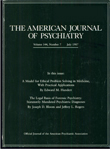Effects of d-amphetamine on urinary metabolites of dopamine and norepinephrine in hyperactive boys
Abstract
The authors measured the urinary metabolites 3-methoxy-4- hydroxyphenylglycol (MHPG) and homovanillic acid (HVA) in 21 hyperactive boys and 12 matched healthy boys. The hyperactive boys excreted lower amounts of MHPG than control boys. Hyperactive drug responders excreted lower amounts of HVA than control boys and hyperactive nonresponders. Drug responders with normal MHPG excreted low amounts of HVA and those with normal HVA excreted low amounts of MHPG. d-Amphetamine decreased MHPG in all drug responders and HVA in drug responders with normal HVA levels, although it tended to increase HVA in those with low HVA levels. The authors discuss their data in terms of the possible involvement of norepinephrine and dopamine in the etiology of hyperactivity in children.
Access content
To read the fulltext, please use one of the options below to sign in or purchase access.- Personal login
- Institutional Login
- Sign in via OpenAthens
- Register for access
-
Please login/register if you wish to pair your device and check access availability.
Not a subscriber?
PsychiatryOnline subscription options offer access to the DSM-5 library, books, journals, CME, and patient resources. This all-in-one virtual library provides psychiatrists and mental health professionals with key resources for diagnosis, treatment, research, and professional development.
Need more help? PsychiatryOnline Customer Service may be reached by emailing [email protected] or by calling 800-368-5777 (in the U.S.) or 703-907-7322 (outside the U.S.).



